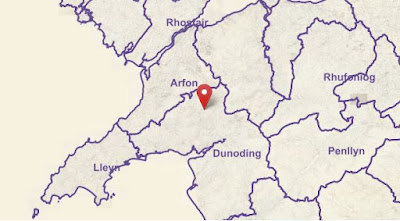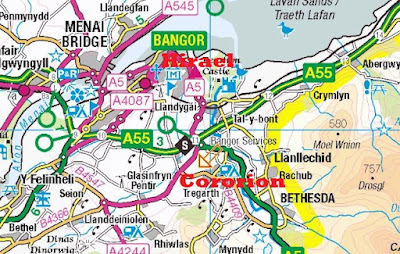Many Arthurian researchers have delved into the possible historical nature of whoever may have been the actual lord of Dinas Emrys. It is well known that as it stands, the folktale of Vortigern and Ambrosius/Emrys (for whom Geoffrey of Monmouth later substituted his Merlin/Myrddin) is just that - an interesting traditional episode without historical value. The folktale itself is complex, and I have dealt with it in great detail elsewhere. A sort of addendum to the story is the supposed original name of the fort - Dinas Ffaraon Ddande, which can easily be shown to include an epithet for Vortigern derived from Gildas.
Clearly, though, Dinas Emrys was an important site. It has produced evidence for Iron Age, Roman and early Medieval occupation (https://coflein.gov.uk/en/site/95284/). But to whom did it belong in the age of Uther and Arthur?
I think I may now know the answer to that question. There are a couple of clues embedded in the Vortigern-Emrys story.
Firstly, Emrys is brought to the fort to act as a foundation sacrifice. The druids of Vortigern are in charge of this enterprise, and we must presume that the said sacrifice, designated as particularly sacred because he had no human father, was being dedicated to a deity. Archaeology has found such foundation sacrifices, and they can, indeed, be children. The druids felt it was necessary to give Emrys to a specific deity, so that the fortress would remain firm and stop sinking into the ground.
Secondly, after Emrys reveals to Vortigern and the druids why the fortress is sinking, and then explains the symbolic nature of the dragons in the pool, the high king gives (L. dedit) Dinas Emrys and all of western Wales, i.e. Gwynedd, to the boy.
The folktale is thus bracketed with a sort of double gifting - the boy to the deity as a sacrifice, and the fort and western Wales to the boy to rule over.
We next need to consult with the The List of Historic Place-Names of Wales
(https://historicplacenames.rcahmw.gov.uk/) on the early cantref in which Dinas Emrys was situated. This was the response from Dr James January-McCann of that organization to my query on this subject:
"Dinas Emrys was very much in Dunoding."
Ah ha! Now we were getting somewhere.
Dunod was a son of the great Cunedda, and Dunoding was his kingdom in Gwynedd. The name is a Welsh form of the Latin Donatus. Yes, you have read that correctly. This name is directly related to L. donum and its derivatives. Surprisingly, L. dedit shares the same root (do). I will list all the relevant words and their definitions from various respectable sources below.
Dinas Emrys in Dunoding Cantref (courtesy https://historicplacenames.rcahmw.gov.uk/)
Dinas Emrys in Eifionydd Commote*
What I am suggesting, of course, is that the fort originally belonged to Dunod, son of Cunedda. But that the name, linked wrongly or fancifully with Latin words for gift and dedication, was co-opted for use in the concocting of the Emrys story. A donum could be a sacrifice given to a deity, and buildings and such could be dedicated to deities. In my opinion, this double-gift motif found in the Dinas Emrys folktale could derive from the fact that Dunod once held the fort and all of the territory around it.
For the giving of gifts in the Roman world, see this excellent article:
And on the Latin words we are interested in:
do , dĕdi, dătum, dăre (also in a longer form, dănunt = dant, Pac., Naev., and Caecil. ap. Non. 97, 14 sq.; Plaut. Most. 1, 2, 48; id. Ps. 3, 1, 1 et saep.; cf. Paul. ex Fest. p. 68, 12 Müll.—
I.Subj.: “duim = dem,” Plaut. Aul. 4, 6, 6; Ter. Heaut. 1, 1, 38: “duis,” Plaut. Capt. 2, 2, 81; id. Men. 2, 1, 42: “duas = des,” id. Merc. 2, 3, 67; id. Rud. 5, 3, 12; an old formula in Liv. 10, 19: “duit,” Plaut. As. 2, 4, 54; id. Aul. 1, 1, 23; an old formula in Liv. 22, 10 init.: “duint,” Plaut. Most. 3, 1, 126; id. Ps. 4, 1, 25; id. Trin. 2, 4, 35; Ter. And. 4, 1, 43; id. Phorm. 3, 2, 34 al.—Imper.: DVITOR, XII. Tab. ap. Plin. 21, 3, 5 ex conject.—Inf.: DASI = dari, acc. to Paul. ex Fest. p. 68, 13 Müll.: “dane = dasne,” Plaut. Truc. 2, 4, 22.—The pres. pass., first pers., dor, does not occur), v. a. Sanscr. dā, da-dā-mi, give; Gr. δί-δω-μι, δωτήρ, δόσις; cf.: dos, donum, damnum, to give; and hence, with the greatest variety of application, passing over into the senses of its compounds, derivatives, and synonyms (edere, tradere, dedere; reddere, donare, largiri, concedere, exhibere, porrigere, praestare, impertire, suppeditare, ministrare, subministrare, praebere, tribuere, offerre, etc.), as, to give away, grant, concede, allow, permit; give up, yield, resign; bestow, present, confer, furnish, afford; offer, etc. (very freq.).
dōnum , i, n. do,
I.a gift, present.
I. In gen., Plaut. Am. prol. 138 sq.; id. Most. 1, 3, 27 sq.; id. Mil. 4, 2, 26; Cic. Clu. 9 fin.; id. Tusc. 5, 7, 20; id. Lael. 15, 55 et saep.: “dona mittunt et munera,” Plaut. Mil. 3, 1, 121; so with munus (usu. dona muneraque, = bribery), id. Cist. 1, 1, 95; Cic. Clu. 24, 66; id. Arch. 8, 18; id. de Or. 2, 71; id. de Sen. 12, 40; Dig. 38, 1, 7 al.—
II. In partic.
A. A present brought to a deity, a votive offering, sacrifice, Plaut. Rud. prol. 23; Lucr. 4, 1237; 6, 752; Cic. Rep. 2, 24 fin.; Liv. 2, 23; 5, 25; Verg. A. 3, 439 et saep.; cf. “turea,” offerings of incense, Verg. A. 6, 225.—
B. Ultima or suprema dona, the last honors, funeral rites, obsequies, Ov. H. 7, 192; Val. Fl. 2, 471; Sen. Hippol. 1273.
dōnātĭo , ōnis, f. id.,
I.a presenting, a donation; in abstr. and concr. (for syn. cf.: “donum, largitio, munus, donativum),” Cic. Phil. 4, 4, 9; Cic. Verr. 2, 3, 80; id. Opt. Gen. 7, 19; id. Rosc. Am. 9; Just. Inst. 2, 7, de donationibus; the same title appears in Dig. 39, 5, and 6; Cod. Just. 5, 3; Vulg. Rom. 5, 17 al.; cf. Rein's Privatr. p. 202 sq., and 340.
dē-dĭco
A. Relig. t. t., to dedicate, consecrate, set apart a thing to a deity or deified person (for syn. cf.: “1. dico, consecro, inauguro, initio.—Class.): nonne ab A. Postumio aedem Castori ac Polluci in foro dedicatam vides?” Cic. N. D. 3, 5, 13: “aedem Saturno,” Liv. 2, 21: “aedem Mercurii,” id. 2, 27 et saep.: “delubrum Homeri,” Cic. Arch. 8 fin.: “simulacrum Jovis,” Cic. Verr. 2, 4, 28: “loca sacris faciendis,” Liv. 1, 21: “aram Augusto,” Suet. Claud. 2: “domum Dei,” Vulg. 2 Par. 7, 5; id. 3 Reg. 8, 63.
b. With the deity as object instead of the temple: “ut Fides, ut Mens, quas in Capitolio dedicatas videmus (i. e. quarum aedes),” Cic. N. D. 2, 23, 61; 2, 31, 79 (cf. however, id. Leg. 2, 11, 28): “Junonem,” Liv. 5, 52, 10: “Apollinem,” Hor. Od. 1, 31, 1; “and even te quoque magnificā, Concordia, dedicat aede, Livia,” Ov. F. 6, 637.—
dēdĭcātĭo , ōnis, f. dedico,
I.dedication, consecration: “aedis,” Liv. 2, 27: “theatri,” Plin. 7, 48, 49, § 158; Suet. Claud. 21: “pontis,” id. Calig. 32: “domus Dei,” Vulg. 1 Esdr. 6, 16: “statuae,” id. Dan. 3, 2 al.
dēdĭtĭo , ōnis, f. dedo, no. I. B.,
I.a (military) giving up, a surrender, capitulation (freq. in the historians).—With subj. gen.: “deditio sui,” Curt. 5, 1, 18.— Plur.: “deditiones cohortium,” Tac. H. 3, 70. —With gen. obj.: “ipsius corporis,” Dig. 9, 4, 1; Liv. 31, 18, 6; but usually absol.: “Helvetii legatos de deditione ad eum miserunt,” Caes. B. G. 1, 27; cf.: “de deditione agere,” id. B. C. 3, 28; 3, 97: “aliquem in deditionem petere,” Aur. Vict. Vir. Ill. 23, 7: “aliquem in deditionem accipere,” id. B. G. 1, 28; 2, 13; Sall. J. 29, 5; Liv. 23, 30 et saep.: “seque in deditionem ut recipiat,” Caes. B. G. 3, 21 fin.: “in deditionem redigere,” Flor. 3, 10, 25: “deditionis condicio,” Caes. B. G. 2, 32: “deditione facta,” id. ib. 2, 33: “subire deditionem,” id. B. C. 1, 81, 5: “in deditionem venire,” to surrender, id. ib. 3, 99, 3; Liv. 9, 20; 40, 33: “omissa deditione,” Sall. J. 66, 1; cf. id. ib. 70, 1 Kritz.: “deditio ad tam infestos,” Liv. 28, 22; cf.: “ad Romanos,” id. 8, 25: “cum locum tibi reliquum non modo ad pacem, sed ne ad deditionem quidem feceris,” Cic. Phil. 13, 21, 48 et saep. An unusual combination is deditionem suam ad aliquem absentem mittere, Flor. 3, 7, 5; v. Graev. ad loc.
*
Eifionydd was named for Ebiaun, the son of Cunedda. However, the name Ebiaun is not Irish. It seems to be cognate (confirmation via Dr. Simon Rodway of The University of Wales) with Gaulish Abianus, a water-god found at Glanum.
"Some inscriptions were probably positioned outside the buildings, in the street,
similar to the Hercules altars at the spring. For example, a votive altar to Abianus was
discovered opposite House VII/VIII to the right of the entrance to the baths. Abianus
– a Celtic theonym meaning ‘Sacred Water’ – seems quite appropriate for the bath
complex and might indicate that the baths might have retained some religious functions
in the Roman period; after all, this is close to the 2nd-century BC temple with dromos
well...
The theonym derives from the root *ab-ya ‘l’eau’, thus probably ‘sacred water’: cf. De Bernardo Stempel 2007; Delamarre 2003, 29-30, s.v. abona, abu-, ‘rivière’."
If Ebiaun is for a theonym representing a male water god in Eifionydd, I would call attention to the commote's Afon Dwyfor and Afon Dwyfach rivers. These rivers run through the center of the commote from north to south. What is special about them is the meaning of their names. The Dwy- element means "Goddess." From Dr. Simon Rodway:
"They are tributaries of the river Dwy, which means ‘god(dess)’, cf. Dyfrdwy, 'water goddess' (Dee) < Deva."
Long ago, in discussing the dragons of Dinas Emrys, I remarked that
"In the Gorchan of Tudfwlch, the hero – from Eifionydd in Gwynedd – is called the serpent with a terrible sting, and his place of origin is alluded to as the snakes’ lair."
As serpent symbolism is often found hand in hand with rivers and lakes, does the Dinas Emrys dragon story betray some relic of belief involving Ebiaun/Abianus and/or the two god(dess) rivers of Eifionydd? It will be recalled that the two vases containing the "tented", i.e. wrapped dragons (which I have always thought to be cremation urns containing the remains of warrior-chieftains, called dragons in Welsh heroic poetry) were found in a pool. For the custom of wrapping cremated remains before placement in an urn, see https://www.researchgate.net/publication/329806802_Wrapped_Up_for_Safe_Keeping_'Wrapping'_Customs_in_Early_Iron_Age_Europe_Archaeological_and_Anthropological_Perspectives.
I once flirted with the idea that the pool of the fort was a confusion for the Llyn Dinas place-name, and pointed to Afon Goch, the Red Water, emptying into the Glaslyn at Dinas Emrys in the Vale of Gwynant. I abandoned the idea when the etymology of Gwynant as 'white stream' turned out to be incorrect. See
Over the next few days or weeks, I will be looking at all this a bit more closely to see if I can come up with anything that will add a dimension to the Dinas Emrys dragon story.
When it comes to vases and water imagery, one need only think of the British goddess Coventina on Hadrian's Wall. To quote from Miranda Green's SYMBOL & IMAGE IN CELTIC RELIGIOUS ART:
"In the triple image, Coventina's water symbolism is indicated by her beaker and her overturned pitcher with water pouring from it. On the single image, the goddess waves a water-lily leaf and reclines on waves; her left arm rests on an upturned jug of water."









